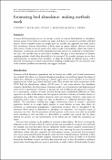Files in this item
Estimating bird abundance : making methods work
Item metadata
| dc.contributor.author | Buckland, Stephen T. | |
| dc.contributor.author | Marsden, Stuart J. | |
| dc.contributor.author | Green, Rhys E. | |
| dc.date.accessioned | 2011-07-25T12:30:00Z | |
| dc.date.available | 2011-07-25T12:30:00Z | |
| dc.date.issued | 2008-09 | |
| dc.identifier | 601511 | |
| dc.identifier | a5ddd5b1-994d-4e63-8b23-5785c8236d94 | |
| dc.identifier | 000259453100007 | |
| dc.identifier | 56649101942 | |
| dc.identifier | 84891824882 | |
| dc.identifier.citation | Buckland , S T , Marsden , S J & Green , R E 2008 , ' Estimating bird abundance : making methods work ' , Bird Conservation International , vol. 18 , no. S1 , pp. S91-S108 . https://doi.org/10.1017/S0959270908000294 | en |
| dc.identifier.issn | 0959-2709 | |
| dc.identifier.other | ORCID: /0000-0002-9939-709X/work/73701075 | |
| dc.identifier.uri | https://hdl.handle.net/10023/1930 | |
| dc.description.abstract | In many bird monitoring Surveys, no attempt is made to estimate bird densities or abundance. instead, counts of one form or another are made, and these are assumed to correlate with bird density. Unless complete Counts Oil Sample plots are feasible, this approach can easily lead to false conclusions, because detectability of birds varies by species, habitat, observer and many other factors. Trends in time of counts often reflect trends in detectability, rather than trends in abundance. Conclusions are further compromised when surveys are conducted at unrepresentative sites. We consider how to avoid these problems. We give a brief description of distance sampling methods, which allow detectability to be estimated. We consider strategies to ease their implementation, to enhance their reliability, to adapt the methods for difficult species, and to deal with circumstances in which representative sampling is problematic. We also consider some of the common problems encountered, and suggest solutions. | |
| dc.format.extent | 18 | |
| dc.format.extent | 121576 | |
| dc.language.iso | eng | |
| dc.relation.ispartof | Bird Conservation International | en |
| dc.subject | Distance sampling surveys | en |
| dc.subject | Point-count surveys | en |
| dc.subject | Atlantic forest | en |
| dc.subject | Density | en |
| dc.subject | Conservation | en |
| dc.subject | Islands | en |
| dc.subject | Habitat | en |
| dc.subject | Census | en |
| dc.subject | Size | en |
| dc.subject | QL Zoology | en |
| dc.subject | Animal Science and Zoology | en |
| dc.subject | Ecology | en |
| dc.subject | Nature and Landscape Conservation | en |
| dc.subject.lcc | QL | en |
| dc.title | Estimating bird abundance : making methods work | en |
| dc.type | Journal article | en |
| dc.contributor.institution | University of St Andrews. School of Mathematics and Statistics | en |
| dc.contributor.institution | University of St Andrews. St Andrews Sustainability Institute | en |
| dc.contributor.institution | University of St Andrews. Centre for Research into Ecological & Environmental Modelling | en |
| dc.identifier.doi | 10.1017/S0959270908000294 | |
| dc.description.status | Peer reviewed | en |
| dc.identifier.url | http://www.scopus.com/inward/record.url?scp=84891824882&partnerID=8YFLogxK | en |
This item appears in the following Collection(s)
Items in the St Andrews Research Repository are protected by copyright, with all rights reserved, unless otherwise indicated.

